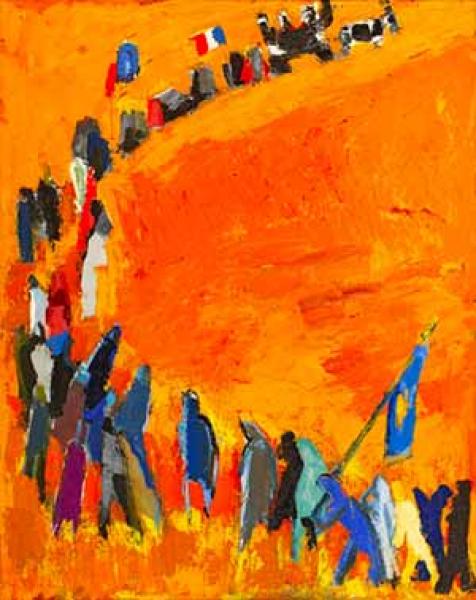La mort du poète, 1966-67
Oil on canvas, signed lower left.
160 x 130 cm
Exhibitions :
Les peintres témoins de leur temps, 1967 (Grand Prix)
Pierre Ambrogiani, Peintures récentes, Galerie Paul Ambroise, Paris, mai-juin 1968, reproduit au livret d’exposition.
Pierre Ambrogiani, Cinquante années de vie artistique, Musée de la Vieille Charité, Marseille, avril-mai 1973, reproduit au catalogue d’exposition sous le n°81.
Pierre Ambrogiani, Le gourmand de couleurs, Fondation Regards de Provence, Palais des Arts, Marseille, 8 mai - 31 août 2008.
Bibliography :
André Alauzen, Pierre Ambrogiani, Editions Tacussel, 1985, reproduit en p.33 sous le n°11.
In 1967, Pierre Ambrogiani was present, as usual, at the Salon des peintres témoins de leur temps, an annual exhibition founded by Isis Kischka in 1951 and held at the Musée Galliera. He presented this spectacular painting entitled The Death of the Poet.
The annual theme chosen for the exhibition being "the song", Ambrogiani's painting echoes a musical composition performed by Gilbert Bécaud, "Quand il est mort le poète", on lyrics by Louis Amade. The subject is thus funereal... and yet, the light air of the song as well as the painting, with a strong yellow dominance, are both surprisingly luminous.
When he died the poet,
All his friends,
All his friends were crying.
When he died the poet,
The whole world,
The whole world wept.
They buried his star,
In a big field,
In a big field of wheat.
And that's why we find,
In that big field,
In this great field of blueberries.
If the song was probably written as a tribute to Jean Cocteau, who had publicly defended Gilbert Bécaud criticized by journalists, the poet of Ambrogiani's painting could be one of the dear friends who accompanied the painter throughout his life, like Francis Carco, who died a few years earlier.
Ambrogiani is also aging, the ardor of youth has left him and around him, the benches are empty and the farewells follow one another. The previous year, at the same Salon des peintres témoins de leur temps, had he not presented a painting that had as its subject the burial of Auguste Chabaud? Proof that the subject of death was of particular concern to him in the late 1960s.
However, this masterful composition in which the funeral procession unfolds like a colourful ribbon rising towards the sky, with the poet at the head, is rather an ode to life, with its bright colors on this almost golden background, which recalls both the wheat field and the star of the song. No lament in this procession, the tragic is put at a distance to magnify the star of the poet, the glow that shines in a brilliant halo on the world. Life always prevails in Ambro.
That year, Pierre Ambrogiani won the Grand Prix awarded by the jury of the Painters Witnesses of their time and Jean Marin awarded him his prize which he accompanied with these words:
"When he died the poet
We buried his star
In a big field of wheat...
And here is that around the "dead poet", around the "big field of wheat" where "one buried his star", Pierre Ambrogiani unrolls the procession of the admirers of the poet: procession clattering of stamens composed of collected and fervent silhouettes. Procession whose moving and colored orb will enclose, in the fidelity of human presences, the solemn return of the red and gold harvest. It is the painting of Piety more than of pain; it is the Rogations of believers who think more about the promise of survival than about the accident of disappearance.
On your canvas, everything is in motion, everything is in movement; one senses that one day the Star, temporarily buried, will rise from the heart of the earth.
The friends of the poet are already preparing to raise their eyes from the grave to carry them towards this light which will have finally taken its place in the Mediterranean sky, of which you are.
Pierre Ambrogiani, with the greatest, the sumptuous Porte-Couleurs."

